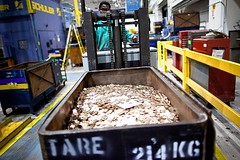
PREV ARTICLE
NEXT ARTICLE
FULL ISSUE
PREV FULL ISSUE
WALL STREET JOURNAL: U.S. PLANNING COIN COMPOSITION CHANGE
Stephen Pradier and another E-Sylum reader forwarded this article from the Wall Street Journal about plans under consideration to alter the composition of U.S. coinage. Here are some excerpts. Among those interviewed for the article were
Rod Gillis of the American Numismatic Association and Ute Wartenberg Kagan, executive director of the American Numismatic Society.
-Editor
The president's plan to save money by making coins from cheaper stuff seems simple on its face. But history shows it would rekindle an emotional debate among Americans who fear changing the composition of their currency will hurt its value. As the White House looks to cut costs across government, "making coins from more cost-effective materials could save more than $100 million a year, which isn't just pocket change," says Dan Tangherlini, the Treasury Department's chief financial officer. The government isn't saying which new materials it might use in coins. Most coin experts say creating non-metal coins would go over like a wooden nickel. Still, industrial porcelain, embedded with an identification chip, is seen as an outside possibility. A more likely candidate: an aluminum alloy, used by other countries for coins. But any switch is likely to be controversial. No other stable nation has changed the metal content of its coinage less frequently. World War II shortages compelled the creation of a steel penny in 1943. The mint returned to copper after a year, even though that required smelting spent shell casings. The nickel's composition has gone unchanged since Thomas Jefferson's likeness was put on the coin in 1938, again with the exception of World War II, when for a brief period silver was added, because nickel was needed for weapons production. A least one group would support a sweeping change in the nation's coinage. Nickel, the most expensive and commonly used metal at the mint, is also the most allergy-producing metal in the world. According to the American Academy of Allergy, Asthma & Immunology, people allergic to nickel who have sustained contact with the metal—used in nickels, quarters and dimes—develop an itchy, poison-ivy-type reaction that can last up to a month. "My husband always has these weird rashes on his leg from the change in his pocket," a treasury official involved in the coinage plans says. "Maybe he would benefit from a plastic quarter." To read the complete article, see: Will Nickel-Free Nickels Make a Dime's Worth of Difference? (online.wsj.com/article/SB10001424052748704866204575224431682671088.html) David Gladfelter adds: I say, let's get rid of the mill. We would have to fight the gasoline retailers lobby on that one. Wayne Homren, Editor The Numismatic Bibliomania Society is a non-profit organization promoting numismatic literature. See our web site at coinbooks.org. To submit items for publication in The E-Sylum, write to the Editor at this address: whomren@gmail.com To subscribe go to: https://my.binhost.com/lists/listinfo/esylum All Rights Reserved. NBS Home Page Contact the NBS webmaster 
|
